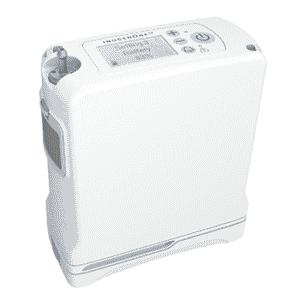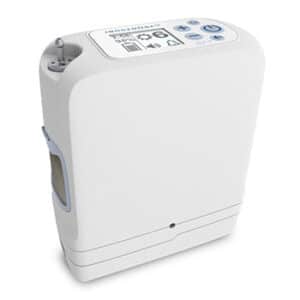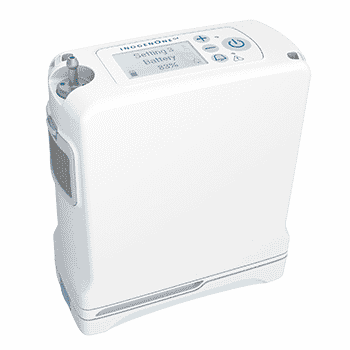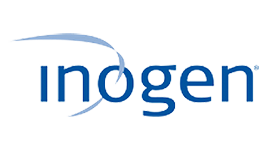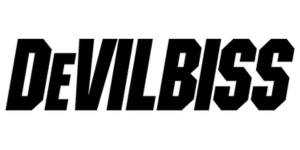The Inogen One G4, a portable intermittent flow oxygen concentrator, is lighter than the G5, making it the lightest model on this list. If weight and ease of portability are your most important considerations, the G4 may be a good fit.
Inogen Portable Oxygen Concentrator Review 2025
Inogen offers two travel-friendly, FAA-approved portable oxygen concentrator models, which means that each model is approved for use on airplanes by the FAA. The company also offers one home oxygen concentrator. Keep reading for our Inogen portable oxygen concentrator review and to discover the pros, cons, and costs of each model so you can determine the best oxygen concentrator for you.
Why Inogen is one of our top picks
We chose to review Inogen because it offers one of the smallest portable oxygen concentrators on the market—the Inogen One G4—and because all of its models are FAA-approved (suitable for use on an airplane).
When researching Inogen, we also liked that Inogen has two warranty options, a robust frequently asked questions section on its website, and a convenient purchasing option. A notable drawback is that the company only offers intermittent flow options, also known as pulse flow, which may not work for those who need a continuous flow portable oxygen concentrator.
We’ll cover some pros and cons of the Inogen One models, how to purchase these portable oxygen concentrators, and how the company compares to other brands.
Pros and cons of Inogen
Table 1 Comparison of Inogen portable oxygen concentrators, as of 2025
|
Inogen One G4
Check Price
|
Inogen One G5
Check Price
|
Inogen At Home
Check Price
|
|
|---|---|---|---|
| Cost | $1,895–$2,744 | $2,882–$3,079 | $1,703 |
| Flow type | Pulse flow | Pulse flow | Continuous flow |
| Flow settings | 1–3 | 1–6 | 1–5 |
| Max oxygen output | 0.63 L/min | 1.26 L/min | 5 L/min |
| Noise level | 40 dB (setting 3) | 39 dB (setting 2) | 40 dB (setting 2) |
| FAA-approved | Yes | Yes | No |
| Bluetooth capabilities | Yes | Yes | No |
| Warranty or protection plan | 3 years | 3 years | 3 years |
| Free trial | Yes, 7 days risk-free | Yes, 7 days risk-free | Yes, 7 days risk-free |
Inogen portable oxygen concentrator reviews
Features
- Cost: $1,895–$2,744, depending on the battery
- Weight:
- 2.8 pounds with single battery
- 3.3 pounds with double battery
- Dimensions:
- 5.91 inches long x 2.68 inches wide x 7.2 inches high with single battery
- 5.91″ L x 2.68″ W x 7.79″ H with double battery
- Battery life:
- 2 hours, 40 minutes on setting 1; 2 hours, 15 minutes on setting 2 with single battery
- Up to 5 hours on setting 1 with double battery
- Battery charging time: 3 hours, 25 minutes for single battery
- Delivery/flow type: Pulse flow
- Range of flow settings: 1–3
- Noise level: 40 dB
Accessories
The Inogen One G4 comes with the following supplies:
- Portable oxygen concentrator unit
- Nasal cannula
- Wall (AC) charger/power cord
- Car (DC) charger/power cord
- One rechargeable battery
- Custom carrying bag
- Carry strap
- User manual
Inogen offers additional accessories for purchase with the G4, such as a custom G4 backpack, carrying bag, and hip bag.
Additional information
The Inogen One G4 is the cheapest option for an Inogen portable oxygen concentrator with Bluetooth capabilities. The other model on this list, the G5, costs about $200 more on average.
All Inogen portable oxygen concentrators have a similar noise level—the G4 is 40 decibels, and the G5 is 38. You can charge the G4 on AC power inside the home or use DC power in a car or airplane. Inogen also offers an optional external charger for when you’re away from home.
Drawbacks
The G4 offers the lowest battery life on this list, providing less than 3 hours of power on setting 1.
In addition, the G4 has fewer oxygen flow settings (1–3) than the G5’s 1–6 flow settings. Fewer settings may mean less variability between adjustments.
The G4 isn’t water-resistant, but Inogen has stated that the concentrator was tested to withstand rain for short periods, such as while transferring it from a car to a home. Adding a carrying bag will provide another layer of protection for your portable oxygen concentrator.
Inogen also recommends avoiding running your G4 in temperatures lower than 41˚F or higher than 95˚F for an extended time since extreme temperatures can shorten your battery life.
Inogen connect app
The G4 does have Bluetooth capabilities, allowing you to use your smartphone or tablet to connect to your concentrator through the Inogen Connect App, which you can download from the App Store and Google Play.
The app allows you to view information such as the concentrator’s filter life, nasal cannula life, battery cycles, and battery status. It also alerts you to software updates for your concentrator. This helps keep the machine working properly.
Filter life shows the number of days since the filters were last cleaned, making it easier to remember to schedule the recommended weekly cleaning. Cannula life shows the number of days since the cannula was last changed, which should be replaced based on your physician’s instructions. Finally, the battery cycle shows the number of times you have fully charged the battery. The G4’s battery lasts for 500 total charges.
The G4 could be a good option for those searching for a lighter machine with an app connection that they can purchase rather than rent. If you are looking for longer battery life, lower noise level, and more flow settings, the G5 might be a better choice.
Features
- Cost: $2,882–$3,079, depending on the battery
- Weight:
- 4.7 pounds with single battery
- 5.7 pounds with double battery
- Dimensions:
- 7.19 inches long x 3.26 inches wide x 8.15 inches high with single battery
- 7.19″ L x 3.26″ W x 9.03″ H with double battery
- Battery life:
- 6.5 hours on setting 1; 5 hours on setting 2 with single battery
- Up to 13 hours on setting 1 with double battery
- Battery charging time: 4 hours for single battery
- Delivery/flow type: Pulse flow
- Range of flow settings: 1–6
- Noise level: 39 dB
Accessories
The Inogen One G5 comes with the following supplies:
- Portable oxygen concentrator unit
- Wall (AC) charger/power cord
- Car (DC) charger/power cord
- One rechargeable battery
- Custom carrying bag
- User manual
You can purchase additional accessories for your G5, such as a custom G5 backpack, carry bag, and cart to help transport your portable oxygen concentrator.
Additional information
The G5 has the longest battery life of the two portable models, reaching 6.5 hours on setting 1 with one battery and up to 13 hours with the optional double battery. This option is great if you’re looking for a long battery life. While the battery lasts longer, it does take 35 minutes longer to charge fully than the G4’s battery, clocking in at 4 hours of charging time.
Like the G4, the G5 has Bluetooth capabilities, allowing you to use your smartphone or tablet to connect to the Inogen Connect app to check the status of your filter, cannula, and battery life, and to access the user manual, FAQs, and troubleshooting tips. Having these resources available through your smartphone or tablet is convenient. It can make getting to know your portable oxygen concentrator easier, saving time and energy and helping you schedule recommended filter and cannula cleanings.
Drawbacks
The G5 has a lot going for it—it has the longest battery life, the most flow settings, and the lowest noise level of any model on this list. But it is the most expensive, at about $200 more on average than the G4.
It’s also the heaviest portable model on this list.
But higher cost and weight are the only notable drawbacks of the G5 compared to the G4. It outperforms the G4 in every other criteria we used to evaluate these models.
The G5 model may be a good fit for those who want a longer battery life, a quieter machine, and Bluetooth technology. If you want a lighter portable oxygen concentrator, you might prefer the G4 model.
Product Availability
Inogen plans to discontinue the G5 and replace it with the Rove 6 in early 2024 to comply with European regulations. The Rove 6 will be extremely similar to the G5 model.
Features
- Cost: $1,703
- Weight: 18 pounds
- Dimensions: 7″ L x 13″ W x 16.5″ H
- Battery life: Not applicable; runs on electricity
- Battery charging time: Not applicable; runs on electricity
- Delivery/flow type: Continuous flow
- Range of flow settings: 1–5
- Noise level: 45 dB
Accessories
The At Home Oxygen Concentrator comes with the following supplies:
- Oxygen concentrator unit
- Wall (AC) charger/power cord
- Nasal cannula
- User manual
Additional information
The Inogen At Home oxygen concentrator is a light 18 pounds, which is almost half the weight of most home oxygen concentrators. Similar to Inogen’s more portable options, its noise level is around 40-45 decibels, allowing users to still hear a television or carry on a conversation while using the device. We also like the Inogen At Home device’s low power usage and space-saving design.
Drawbacks
The biggest drawback of the At Home concentrator is that it’s generally more expensive than other non-portable concentrators. Also, because it isn’t a portable concentrator, it’s not FAA approved and its use on airplanes isn’t permitted.
Another drawback is that the At Home model doesn’t have Bluetooth capabilities and doesn’t connect to the Inogen Connect App like the G4 and G5 machines do. The app is a useful tool that allows you to check your battery life, monitor your oxygen use, and more.
Inogen history
Inogen was founded in 2001 by University of California, Santa Barbara, graduates Alison Bauerlein, Brenton Taylor, and Byron Myers after their idea for a portable oxygen concentrator won the 2001 UCSB New Venture Competition.
Inspired by Bauerlein’s grandmother, Mae, who complained to her granddaughter about the inconveniences and limitations of using a heavy oxygen tank, the group went on to create Inogen, the first company to make portable oxygen concentrators available to the public. The mission behind the company was to help patients lead healthier, more active lives.
How to set up Inogen oxygen concentrators
On the Inogen website, there are several YouTube tutorial videos, including step-by-step videos on setting up Inogen’s portable oxygen machines. For example, the Inogen G5 video outlines nine simple steps for setting up your Inogen G5:
- Step 1: Remove your Inogen G5 from the carrying bag
- Step 2: Place the battery in your Inogen G5
- Step 3: Ensure the particle filters are in place
- Step 4: Charge the battery
- Step 5: Connect the nasal cannula
- Step 6: Turn on the G5
- Step 7: Set the flow setting
- Step 8: Position the nasal cannula
- Step 9: Get comfortable with the G5
If you need assistance with setup, contact Inogen’s customer care team 24/7 at 877-466-4364.
How much do Inogen portable oxygen concentrators cost?
Inogen portable oxygen concentrators vary in cost, ranging from $1,895 to $2,882, depending on the battery (single or double) and warranty you select.
On the Inogen website, you can purchase the G4 and G5 machines directly from the company.
- The Inogen One G4 costs $1,895–$2,744, depending on the battery.
- The Inogen One G5 costs $2,882–$3,079, depending on the battery.
- The Inogen At Home costs $1,703.
There are no financing or payment plan options available, but Inogen does offer a 7-day risk-free trial for all of its portable oxygen concentrators.
How to pay for Inogen portable oxygen concentrators
To buy the G4 or G5, make sure you have a current oxygen therapy prescription from your doctor, then go to the Inogen website to choose the model you’d like to purchase. Inogen can bill Medicare or insurance directly.
After you select the model, battery type (single or double), and warranty options (3-year or lifetime), click “Add to Cart.” You can make your purchase using a Visa, Mastercard, American Express, or Discover credit card. After you submit, an Inogen representative will confirm your order by phone.
To purchase the At Home model, you’ll need to have a current prescription from your doctor. With your prescription information in hand, go to the Inogen website, choose a warranty option (3-year or lifetime), and click “Add to Cart.” Just like the portable concentrators, the At Home can be purchased with a Visa, Mastercard, American Express, or Discover credit card.
Inogen app and accessories
Inogen offers the Inogen Connect App for the G4 and G5. The app is not available for the At Home. The app allows users to monitor information such as battery life, battery status, nasal cannula life, filter life, column life, and more. Checking this information easily helps ensure peace of mind that your portable oxygen concentrator is operating optimally and keeping you safe and healthy.
Several accessories and replacement parts are available for Inogen’s portable oxygen concentrators.
| Accessories | Cost | Compatible Models |
|---|---|---|
| External battery charger | $330 | G4, G5 |
| Replacement column pair | $114 | G4, G5 |
| AC power supply | $91–$172 | G4 ($91); G5 ($172) |
| AC power cord | $23 | At Home |
| DC power cable | $79 | G4, G5 |
| Replacement particle filter | $14–$24 | G4 ($14); G5 ($24) |
| Transportation cart | $145 | G4 |
| Carrying bag | $28–$68 | G4 ($28); G5 ($68) |
| Backpack | $116 | G4, G5 |
| Batteries | Single: $393; Double: $597 | G4 and G5 |
| Carrying strap and hip bag | Strap: $17; Bag: $68 | G4 |
Users can purchase these accessories and replacement parts online at the Inogen website using a major credit card.
Inogen warranty, maintenance, and care
All of Inogen’s portable oxygen concentrator models offer a 3-year standard warranty, including three years on the concentrator, one year on the sieve beds (the filters inside the oxygen concentrator), battery, and accessories. Inogen customers can also upgrade to a lifetime warranty for an extra cost, which varies for each model.
To clean your portable oxygen concentrator, Inogen recommends cleaning your nasal cannula daily, the concentrator case when it gets dusty, and the particle filters—which are the filters on the front—weekly. You can use a damp washcloth with water and a mild detergent to clean the particle filters.
For battery maintenance, Inogen recommends keeping batteries dry at all times and avoiding using the portable oxygen concentrator in temperatures less than 41 F or higher than 95 F.
Table 2 Comparison of Inogen vs. other portable oxygen concentrators, as of 2025
|
Inogen
Check Price
|
CAIRE
Check Price
|
DeVilbiss
Check Price
|
Philips Respironics
Check Price
|
|
|---|---|---|---|---|
| Cost | $1,895-$2,882 | $2,400-$2,995 | $3,562 | $2,995 |
| Flow type | Pulse | Pulse | Pulse | Pulse |
| Weight (pounds) | 2.8–4.7 | 5.0 | 4.8 | 5.0 |
| Battery life (hours) | 2.3–13.0 | 8.0–16.0 | 3.5 | 4.5–9.0 |
| FAA-approved | Yes | Yes | Yes | Yes |
Inogen oxygen concentrator customer reviews
Inogen is accredited by the Better Business Bureau (BBB) and has a customer rating of 1.18 stars out of 5, based on 39 customer reviews.8
While Inogen’s BBB customer rating is low, it’s worth noting that it’s accredited by the BBB with an A+ rating. Customer reviews don’t factor into the BBB ratings—those are determined by things like whether the company responds to complaints in a timely fashion and whether customers are satisfied with the way their complaints were handled.
The company is also verified on Trustpilot, with an “great” rating of 4 out of 5 stars, based on more than 3,100 reviews.9
“Arrived on time with no hassles. Been using it every night. If I stop breathing, or the cannula falls out, it starts beeping at me!”
JAMES, VERIFIED CUSTOMER REVIEW (TRUSTPILOT.COM)
“I now have the freedom to travel to visit family and not have to worry about low blood oxygen. So light that it weighs less than my purse. I purchased the G4, which meets my needs now, but wish I would have purchased the G5 for the higher oxygen levels settings for future needs.”
LINDA, VERIFIED CUSTOMER REVIEW (TRUSTPILOT.COM)
“I really like the portability of the unit I have now, and I’m glad I bought it with both a small battery and a large one. However, I find the larger battery to be exhausting to carry, and if I had it to do over, I would have bought another small one. I don’t find it particularly quiet, but I used it at a Broadway performance of Hamilton the first time out, and no one seemed bothered at all.”
BARBARA, VERIFIED CUSTOMER REVIEW (TRUSTPILOT.COM)
Bottom line
Inogen offers two lightweight (2.8–4.7 pounds), pulse flow oxygen concentrators that are all FAA-approved. The company also has one at-home continuous flow model. Though the prices vary from $1,895–$3,079, there are different options to choose from that can change the cost: the battery (single or double) and the warranty (3-year or lifetime).
Inogen may be the right choice if you want pulse flow and a lighter oxygen concentrator. If your doctor or health care provider has prescribed a continuous flow oxygen concentrator and you would prefer to have a portable model, you will need to select another type of portable oxygen concentrator.
Frequently asked questions
Inogen portable oxygen concentrators work well and are a good option for those looking for intermittent flow and FAA-approved portable oxygen concentrators. Inogen offers two portable models: Inogen One G4 and Inogen One G5. The company also has one at-home continuous flow model: Inogen At Home.
Inogen’s portable oxygen concentrators are reliable and easy to use. The G4, and G5 settings buttons are easily visible. These devices also have a range of oxygen flow settings that allow users to adjust the flow based on their health care provider’s recommendations: 1–3 settings for the G4, and 1–6 settings for the G5.
The rechargeable battery is easy to replace and the company has video instructions on its website. You can view the battery level on the device or, for the G5 models, on the Inogen Connect smartphone app.
Portable oxygen concentrators can last approximately four to six years. Proper care and servicing specified by each manufacturer can determine how long oxygen concentrators last. For example, the expected life of the Inogen G4 is five years with proper care and management. Something to keep in mind: The sieve beds, or metal columns, inside the oxygen concentrator last approximately one year, so they will need to be routinely replaced.
Inogen portable oxygen concentrators last 2.25–13 hours on a single charge, depending on the model, battery, and flow setting.
To help extend your battery life, Inogen recommends you charge your battery to 100% and aim to use about 50% before recharging. This will help the battery hold a charge more effectively.
Yes, you can use your Inogen portable oxygen concentrator while charging the battery. When you plug the concentrator into an external power supply, whether at home or in a car or on an airplane, you can use the concentrator and charge the battery simultaneously.
To store your Inogen oxygen concentrator, make sure to avoid extreme temperatures, such as what might occur in a basement or shed, or in a hot or cold car, and don’t store it while the device is plugged into a charging station. Also, to prevent damage, avoid storing batteries when they have no power left. Inogen recommends storing the machine with a 40–50% battery charge when possible.
The base cost for Inogen portable oxygen concentrators is $1,895–$3,079, and $1,703 for its non-portable model. The total cost will vary depending on the battery and warranty you choose.
Inogen oxygen concentrators work by pulling the surrounding air into the machine and sending it through a compressor. Then, the compressed air goes through a filtration process that removes impurities and nitrogen, which produces 90%–95% pure oxygenated air. That air is then pushed through the machine and tubing to the user.
Medicare won’t cover the full purchase of an oxygen concentrator. But, under certain criteria, Medicare Part B will cover up to 80% of the cost to rent oxygen equipment (including supplemental oxygen, containers, tubing, and other related supplies for the delivery of oxygen) for a period of 36 months.
To buy the G4 or G5, you’ll need to have a current oxygen therapy prescription from your doctor. You’ll go to the Inogen website and choose the model you’d like to purchase, then select the battery type (single or double) and warranty options (3-year or unlimited). Next, click “Add to Cart” and make your purchase using a debit card or any major credit card.
Have questions about this review? Email us at reviewsteam@ncoa.org.
Sources
- 3M. The Sound Around Us. Found on the internet at https://multimedia.3m.com/mws/media/1172941O/decibel-scale-poster-trifecta-hr-pdf.pdf
- U.S. Food and Drug Administration. Pulse Oximeters and Oxygen Concentrators: What to Know About At-Home Oxygen Therapy. Found on the internet at https://www.fda.gov/consumers/consumer-updates/pulse-oximeters-and-oxygen-concentrators-what-know-about-home-oxygen-therapy
- Breathe, European Respiratory Journal. Oxygen devices and delivery systems. Found on the internet at https://breathe.ersjournals.com/content/15/3/e108
- Medicare.gov. Oxygen equipment & accessories. Found on the internet at https://www.medicare.gov/coverage/oxygen-equipment-accessories
- American Lung Association. COPD Prevalence. Found on the internet at https://www.lung.org/research/trends-in-lung-disease/copd-trends-brief/copd-prevalence
- National Heart, Lung, and Blood Institute. What is COPD? Found on the internet at https://www.nhlbi.nih.gov/health/copd
- Better Business Bureau. Inogen. Found on the internet at https://www.bbb.org/us/ca/goleta/profile/medical-supplies/inogen-1236-92003218
- Trustpilot. Inogen. Found on the internet at https://www.trustpilot.com/review/inogen.com

